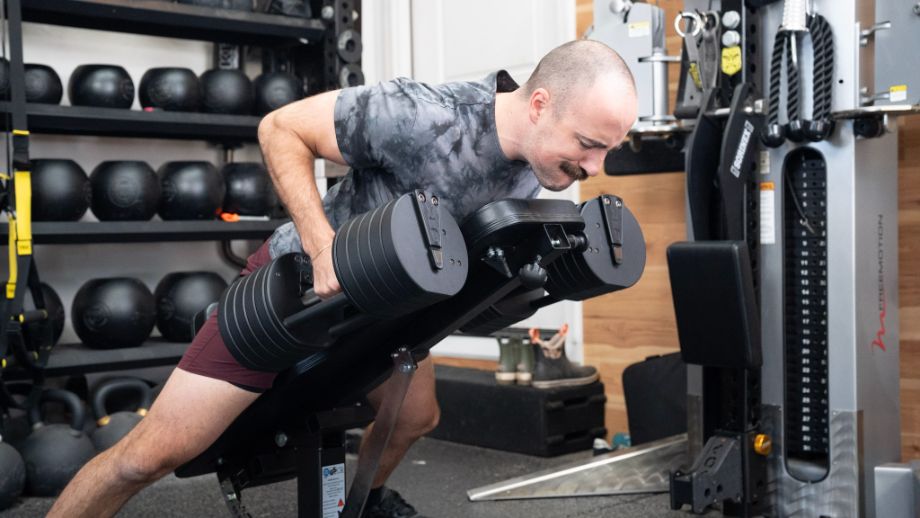We test and review fitness products based on an independent, multi-point methodology. If you use our links to purchase something, we may earn a commission. Read our disclosures.
Excellent examples of the best back exercises include deadlifts, pull-ups, barbell rows, and lat pulldowns. I love all of these, but there’s another exercise I’d like to add to the list based on my 10 years as a fitness enthusiast and certified personal trainer (CPT). You guessed it: Chest-supported rows.
Not only does the chest-supported row build muscle in your back and biceps, you may also find it reduces lower-back strain.
I’ll start this guide by explaining how to do a chest-supported row with the correct form, then give modifications, variations, and alternative exercises to try. I’ll also share the benefits of performing this resistance training exercise and common mistakes to avoid.
So, get those dumbbells ready, and let’s begin!
How To Do A Chest-Supported Dumbbell Row
To perform the chest-supported row, you’ll need a pair of dumbbells and an incline bench. Otherwise, the exercise is similar to the bent-over dumbbell row, with the main difference being that your chest is fixed against the bench instead of free-standing. Although you may need to lower the weight for this, the benefit is that the form is stricter because there’s no way to cheat reps.
How to do it:
- Set an adjustable weight bench to a 30 to 45-degree angle.
- Place a pair of dumbbells on either side of the bench.
- Sit down on the bench, facing the floor. You’ll want your chest to be firmly against the backrest and your feet flat on the ground.
- Grasp the dumbbells. Your palms should be facing each other (neutral grip) and your arms should be extended when in the starting position.
- Brace your core and retract your shoulder blades. Then, row both dumbbells toward your hips simultaneously.
- Hold momentarily before reversing the motion.
- Continue for the desired number of repetitions and sets.
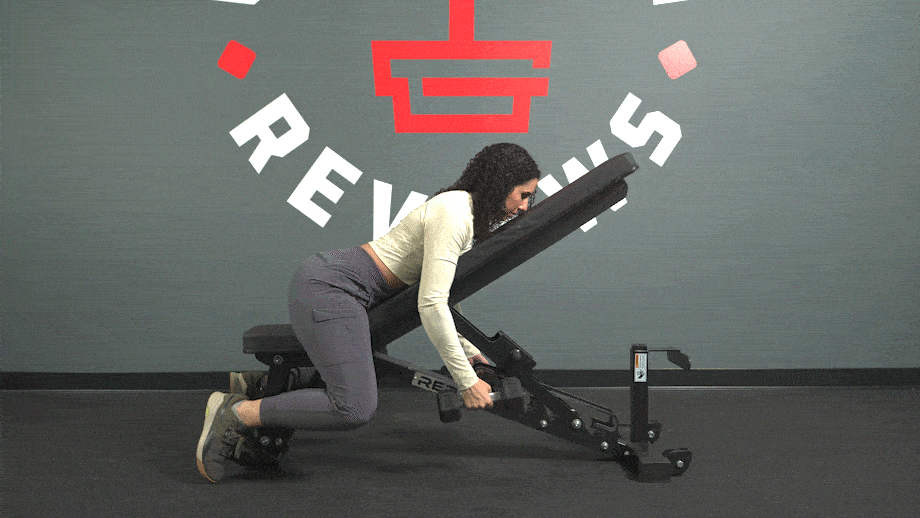
Modifications
- Dial it back: Lower the weight, reduce the number of reps, or reduce the number of sets if you find the chest-supported row challenging. If your gym has one, beginners can use the chest-supported row machine until they’re more comfortable with the movement.
- Make it harder: To make the exercise harder, increase the load or number of reps. You can also pause for a longer period at the top of the movement, or alternatively, try some of the chest-supported row variations below.
How To Do A Chest-Supported Row At Home
To do a chest-supported row at home, consider purchasing a pair of the best dumbbells and one of the best weight benches (if you don’t already have either ). If these aren’t an option, you can use a stability ball or a bench to mimic a bench press and two heavy household objects (such as laundry detergent) for your dumbbells. For the latter, make sure that both objects weigh the same amount.
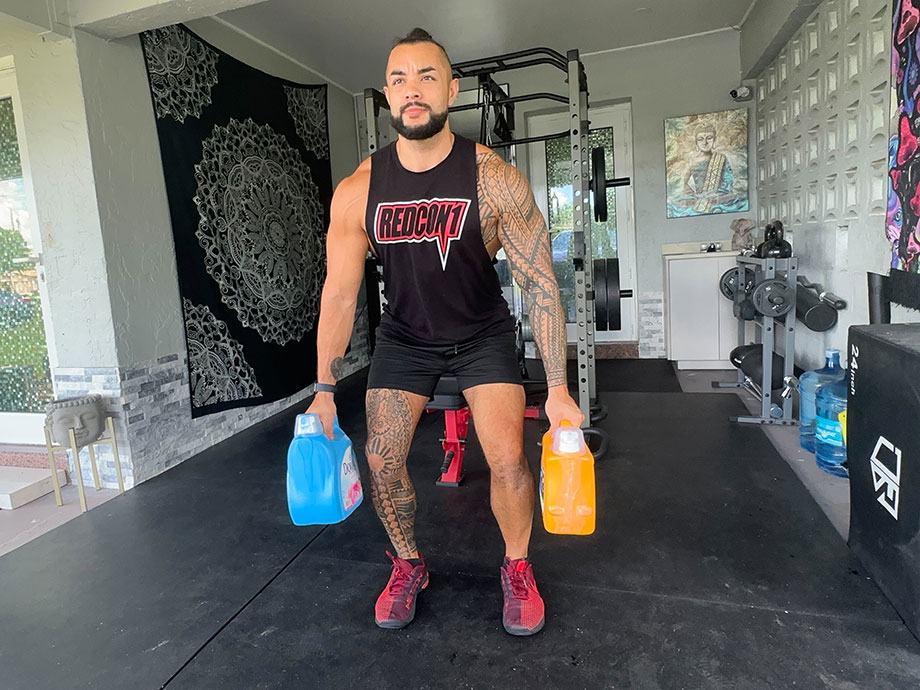
Chest-Supported Row Variations
Once you’ve mastered the chest-supported row, there are a few variations you can conquer next on your quest for gains.
Single-Arm Chest-Supported Row
Instead of doing this back exercise with two dumbbells, work each side of the body separately with a single dumbbell. This method can help to fix muscular imbalances and address bilateral deficits1.
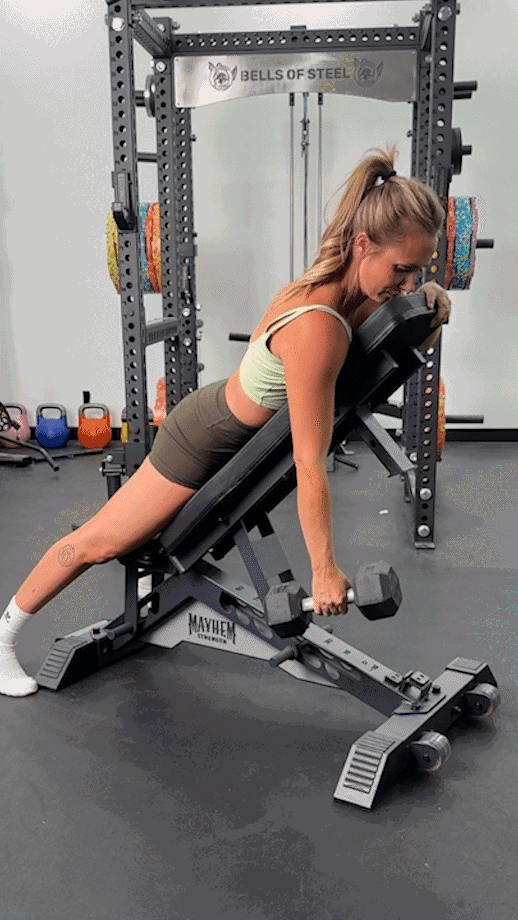
Seal Row
With seal rows, the main difference is that the bench is flat and your legs are completely off the ground. This helps to isolate your back muscles to a greater extent than with chest-supported rows. Although you can do seal rows with two dumbbells, they’re often performed with a barbell and weight plates.
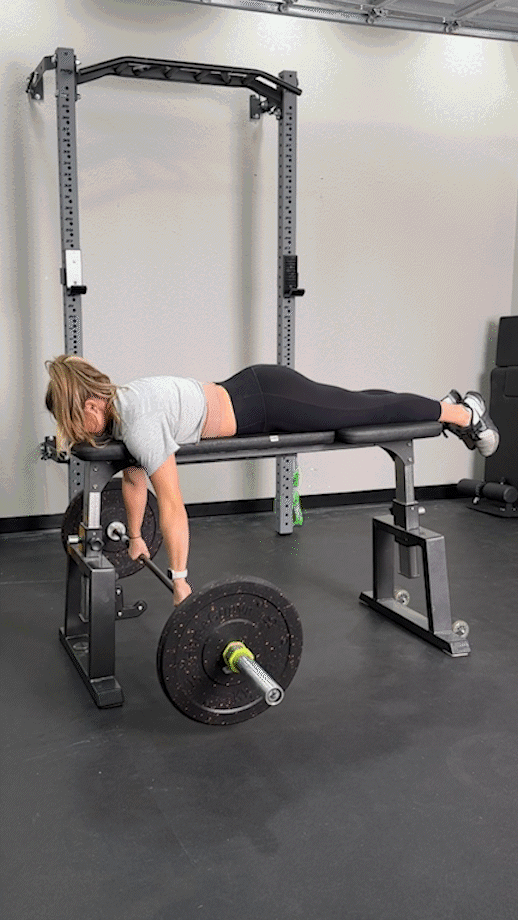
Bent-Over Dumbbell Row
As mentioned above, bent-over dumbbell rows are similar to chest-supported rows, but they don’t require a weight bench. Instead, you’ll hinge at your hips until your torso forms a 45-degree angle. The benefit of doing this row variation is that you may be able to lift heavier loads compared to chest-supported rows.
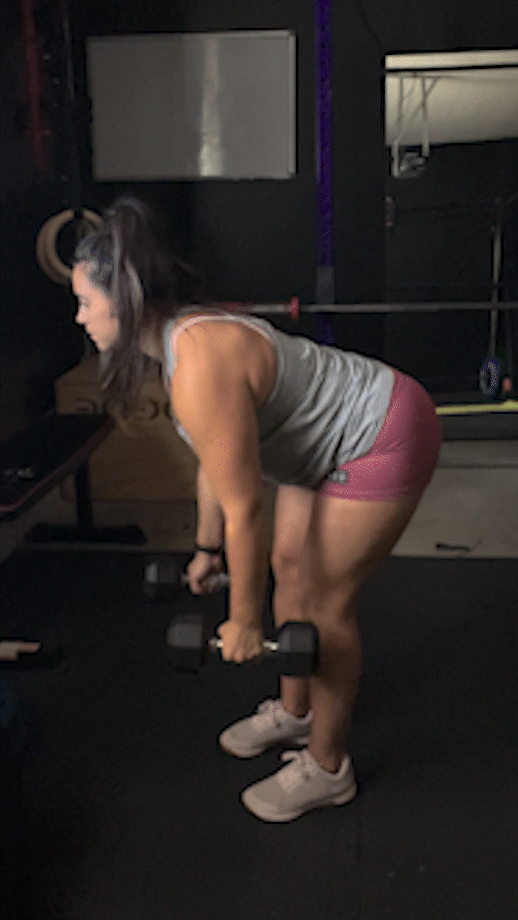
Chest-Supported Row Alternatives
I regularly include the chest-supported row in my back workouts. However, I understand that what works for one person may not work for another. Below are five chest-supported row alternatives:
Suspended/Ring Row
Why do it: I love the suspended/ring row because it works the same muscle groups as the chest-supported row. But, instead of using a pair of dumbbells as resistance, you can use your bodyweight. This helps to develop your core strength. It’s easy to adjust your body position to make the exercise easier or more challenging (the more upright you are, the easier it is).
How to do it:
- Set up a TRX suspension system or rings to hip height.
- Grab the handles with an overhand grip (palms facing the floor) while standing. You’ll want your arms to be fully extended.
- Walk your feet out until you’re comfortable. (The more horizontal you are, the more challenging the exercise.)
- Activate your core and lats. Then, pull yourself up so your chest is as close to the equipment as possible.
- Hold before lowering yourself down until your arms are straight.
- Repeat for reps.
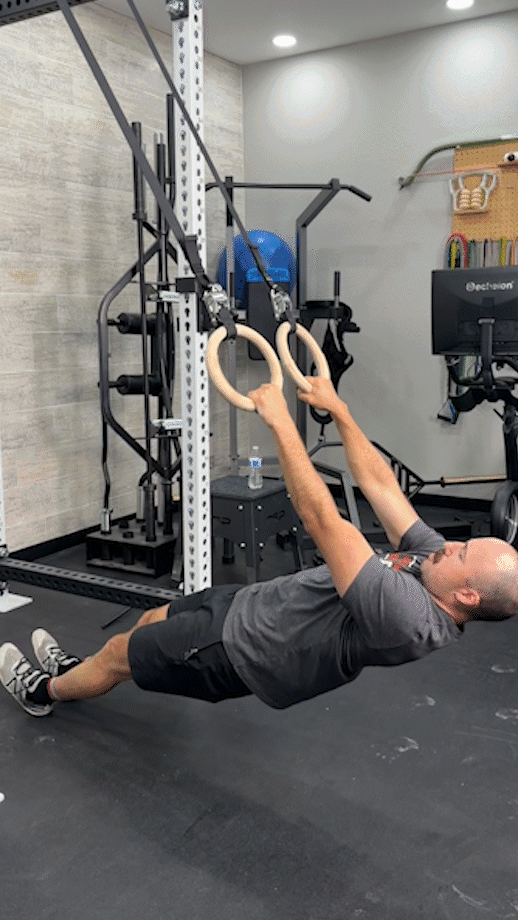
T-Bar Row
Why do it: The T-bar row can help you lift heavier loads than the chest-supported row because you’re using a barbell and weight plates, and your chest isn’t fixed to the bench. If building muscle in your upper body is your primary goal, it’s a fantastic exercise. You can also change your stance and the attachment you use to target different areas of your upper back.
How to do it:
- Secure one end of an Olympic barbell into a landmine base.
- Add weight plates to the other side, and choose your attachment (if you’re going to be using one).
- Stand between the weight plates and the landmine attachment, but closer to the plates. The bar should be between your legs, and you should be facing away from the base.
- Squat down and grab the attachment or bar. The V-bar attachment is the most common, but you can use other attachments, or wrap both hands around the bar.
- Lift the bar off the floor slightly, making sure your arms are fully extended.
- Brace your core, retract your shoulder blades, and bring the bar toward your abdominal region.
- Pause before reversing the motion in a controlled manner.
- Repeat for reps.
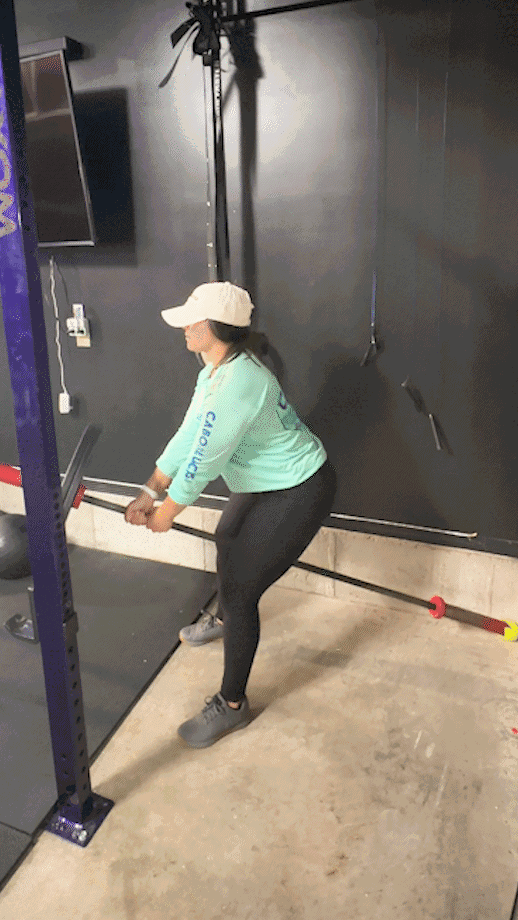
Barbell Bent-Over Row
Why do it: Not only does this bodybuilding exercise work different muscles in your upper body (similar to the chest-supported row), but you’ll also activate muscle groups in your lower body, including the lower back, glutes, and hamstrings. Regularly performing the barbell row will also improve your grip strength, helping with other exercises on this list.
How to do it:
- Place a loaded barbell on the floor.
- Step underneath the bar, similar to how you would with a deadlift. The bar should be close to your shins and your feet should be shoulder-width apart.
- Squat down to take hold of the bar with an overhand grip (palms facing the floor).
- Lift your chest up and engage your core. Then, deadlift the bar toward your pelvic region by driving through your heels.
- Push your hips backward and bend your knees slightly so that your torso is at roughly a 45-degree angle. The bar will be near your knees in the starting position.
- Tuck your elbows into your sides before rowing the bar toward your abdominal region.
- Pause momentarily before slowly returning the barbell to its original position.
- Repeat for the desired number of reps.
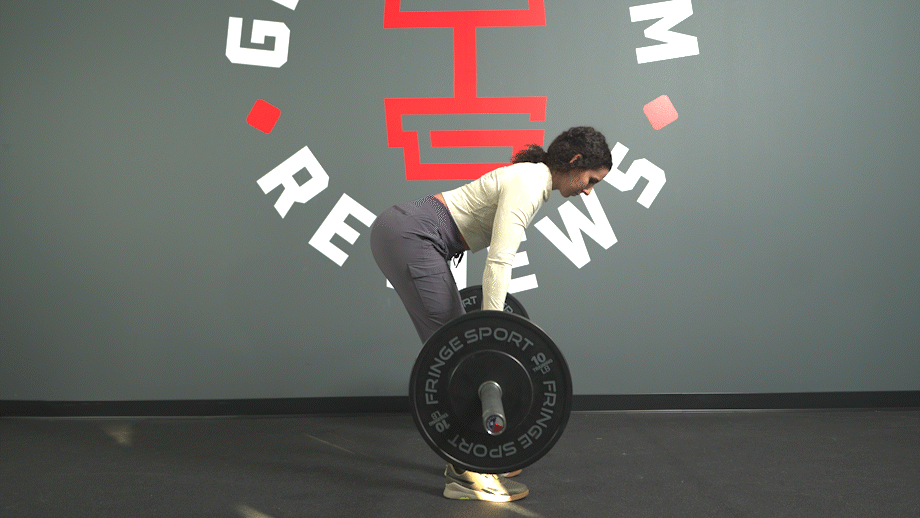
Expert tip: If you have access to one of the best squat racks at home or in the gym, place safety pins on either side and rest the barbell there. When you’re ready to row, simply lift the bar and take a couple of steps backward. This set-up saves you from having to deadlift off the floor, and may result in you getting an extra rep or two.
Seated Cable Row
Why do it: Knowing how to do a seated cable row is important for two reasons. First, the seated cable row machine provides stability and a straighter path through the entire range of motion, making it safer than the chest-supported row. Also, the cables provide constant tension on your back and biceps muscles, which may help to increase muscle mass.
How to do it:
- Select your desired attachment. The V-bar attachment is the most common, but you can also use a straight bar, wide bar, or rope.
- Choose the appropriate weight by adjusting the pin.
- Sit on the bench (or ground) with your feet firmly against the foot pads. You’ll want a slight bend in your knees, and a straight back.
- Lean forward to grab the attachment, making sure that your arms are extended.
- Retract your scapula and activate your core. Then, row the attachment into your abdominal region.
- Hold for a moment before slowly returning the cable to the starting position.
- Continue for reps.
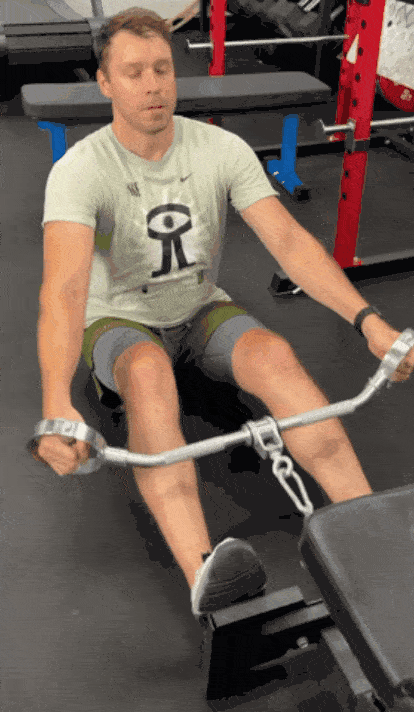
Inverted Row
Why do it: Inverted rows only require your bodyweight, so unlike chest-supported rows, they can be done from (nearly) anywhere. A 2016 Journal of Strength and Conditioning Research2 study found that inverted row exercises activated the latissimus dorsi, upper trapezius, middle trapezius, lower trapezius, and biceps brachii at “levels conducive to strengthening,” highlighting the effectiveness of the exercise.
How to do it:
- Adjust the J-hooks on a squat rack so the bar is at hip height. Alternatively, you can use a Smith machine to perform this exercise. (You can also get very creative by placing a broom handle between two chairs.)
- Sit on the floor, directly underneath the bar.
- Place your hands on the bar using an overhand grip (palms facing away from you). Your arms should be fully extended and perpendicular to the barbell.
- Walk your feet out until you’re comfortable. The closer your feet are to your body, the easier the exercise.
- Activate your core, squeeze your glutes, and pull yourself toward the bar.
- Continue until your chest is as close as possible to the bar, and then pause.
- Lower yourself back down to your original position in a controlled manner.
- Repeat for reps.
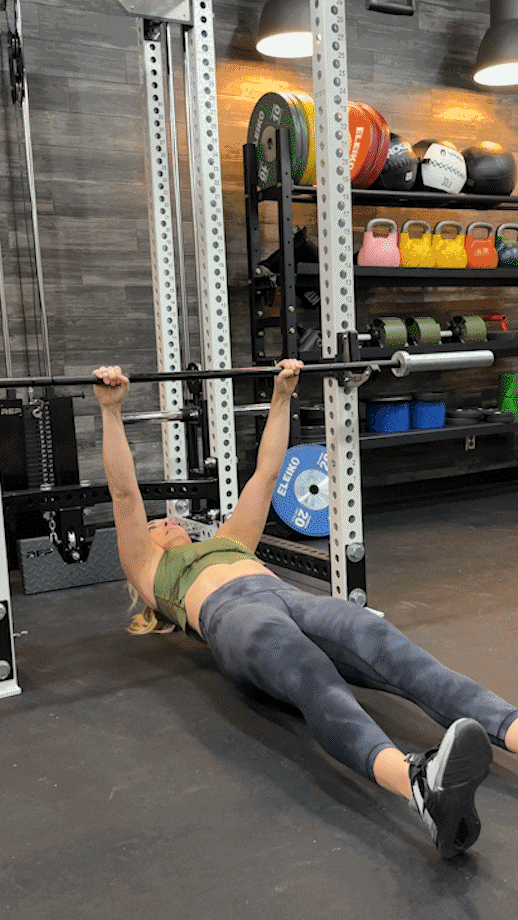
Benefits Of The Chest-Supported Row
Why should you include the chest-supported row in your back-day workouts? The benefits include hypertrophy of the back and biceps, a reduction in lower back pain, and improved posture, to name a few. Read below for more:
Hypertrophy of the Back and Biceps
I’ll go into more detail on this below, but for now, it’s important to know that the chest-supported row targets the muscles in the back and biceps. Because your chest is fixed against a bench—rather than being free—it isolates these muscle groups. This means that you can’t do cheat reps, and this could lead to an increase in muscle size.
RELATED: How To Build Muscle
May Help Reduce Strain On Your Lower Back
Strength training exercises like barbell rows, Pendlay rows, Yates rows, and more may lead to low-back pain. As a certified personal trainer (CPT), I’ve switched clients to the chest-supported row because the exercises above were causing strain on their lower backs. As soon as I did, we saw a marked improvement in their comfort during back training.
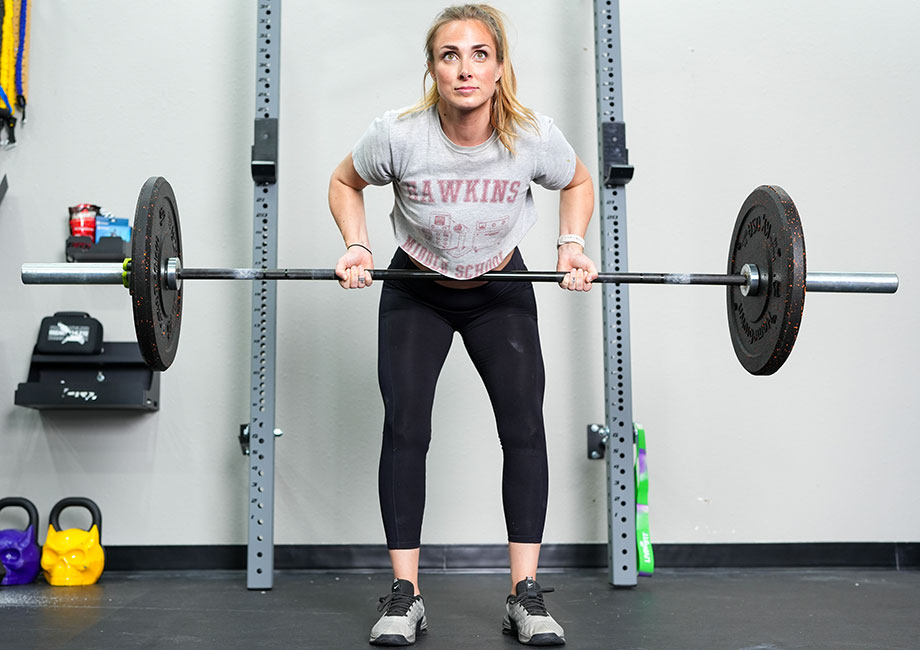
May Lead to Posture Improvements
If you spend a lot of time sitting at a desk or in a car, there’s a chance that you may suffer from poor posture. This tends to get worse as you age. To combat this, it’s important to strengthen your back muscles, which is why the chest-supported row is a great addition to your training program.
Common Chest-Supported Row Mistakes
The chest-supported row may look simple to perform, but let me tell you—it’s not. Here are three common mistakes I see clients and gym-goers make, and more importantly, how to avoid them:
You’re Lowering the Dumbbells Too Quickly
Because of gravity, you may tend to lower the dumbbells too quickly. This isn’t proper chest-supported row form and could be a sign that your weights are too heavy. You want your lifting (concentric) and lowering (eccentric) phases on each rep to be slow and controlled to build muscle. Focus on the mind-muscle connection3 instead of the load you lift.
Your Starting Position Is Too High or Too Low
If your starting position is too low on the bench, you won’t get the correct range of motion with the chest-supported row. This may mean you don’t get the results you’re looking for. In contrast, a starting position that’s too high is awkward and unstable because it’s likely that your feet won’t be flat on the ground. Spend some time figuring out the best starting position for your needs.
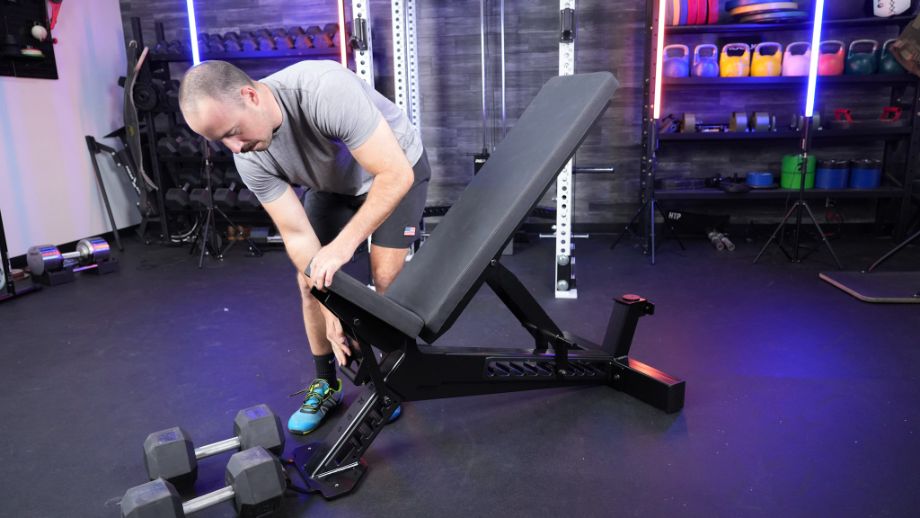
You’re Lifting Your Chest Off the Bench
Your chest should stay against the bench at all times. I’ve seen people in gyms lift their chest off the bench to get the dumbbells to their hips. This is usually a sign that their dumbbells are too heavy. If this is you, lower the weights. Doing this can also help prevent unnecessary injuries, especially in your lower back.
Muscles Worked By the Chest-Supported Row
The chest-supported row primarily targets the muscles in your back and biceps. Here’s a quick breakdown of the areas this exercise will hit:
- Latissimus dorsi
- Rhomboids
- Trapezius
- Posterior deltoids
- Biceps brachii
Chest-Supported Row: Final Thoughts
Although the chest-supported row isn’t as common as back exercises like lat pulldowns or barbell rows, it’s still a great exercise to build muscle in your back and biceps. You may find that compared to other back day exercises, it causes you less strain on your lower back. People with poor posture can also benefit from regularly performing the chest-supported row.
If you decide to try it, first commit to learning proper form by finding the best starting position for your needs because you don’t want to be too high or too low on the bench. Second, choose a weight that’s challenging yet comfortable. When you lower the dumbbells, you want to lower them with control, and your chest shouldn’t lift off the bench at any point. Last but not least, have fun training your back!
Chest-Supported Row: FAQs
What does a chest-supported row work?
A chest-supported row primarily works your upper-, mid-back, and biceps muscles. This includes your latissimus dorsi, rhomboids, trapezius, rear delts, and biceps brachii. You’ll also activate your abdominal muscles and lower back.
Are chest-supported rows better than barbell rows?
Barbell rows and chest-supported rows are both fantastic exercises, so I won’t say that one is better. I regularly include both in my back workouts. I enjoy barbell rows because you can load the bar with heavy weights and work the muscles in your lower body (such as your lower back, hamstrings, and glutes), as well as your upper body.
However, some lifters find that the barbell row causes them strain on their lower back. If this sounds like you, consider trying the chest-supported row instead. Because your chest is fixed against a bench, your back and biceps are better isolated than with barbell rows.
Of course, try both exercises to see which one you prefer.
What is a good weight for a chest-supported row?
A good weight for the chest-supported row depends on a number of factors, including, but not limited to:
-Gender
-Age
-Weight
-Training level
-Personal fitness goals
Beginners may find that five or 10 pounds is a good weight for the chest-supported row, while powerlifters or advanced gym-goers may use 50-pound dumbbells (or even more!). It’s important to start with a weight you’re comfortable with and use progressive overload to increase it over time.
References
- Škarabot J, Cronin N, Strojnik V, Avela J. Bilateral deficit in maximal force production. Eur J Appl Physiol. 2016 Dec;116(11-12):2057-2084. doi: 10.1007/s00421-016-3458-z. Epub 2016 Aug 31. PMID: 27582260.
- Youdas JW, Keith JM, Nonn DE, Squires AC, Hollman JH. Activation of Spinal Stabilizers and Shoulder Complex Muscles During an Inverted Row Using a Portable Pull-up Device and Body Weight Resistance. J Strength Cond Res. 2016 Jul;30(7):1933-41. doi: 10.1519/JSC.0000000000001210. PMID: 26422610.
- Calatayud J, Vinstrup J, Jakobsen MD, Sundstrup E, Brandt M, Jay K, Colado JC, Andersen LL. Importance of mind-muscle connection during progressive resistance training. Eur J Appl Physiol. 2016 Mar;116(3):527-33. doi: 10.1007/s00421-015-3305-7. Epub 2015 Dec 23. PMID: 26700744.
Further reading

Is there any benefit to dry scooping protein powder? An RDN breaks down the purported benefits and risks associated with this viral trend. Read more

In our NordicTrack Elite 3700 Treadmill review, we take a look at the specs of this now-discontinued treadmill. Read more

If your ProForm treadmill breaks down, have no fear—the GGR cardio equipment experts are here to help with this guide to troubleshooting ProForm treadmills. Read more

Meta Description: Is this expensive mass gainer worth the cost? Find out in our MuscleTech Mass Tech Extreme 2000 Review. Read more

